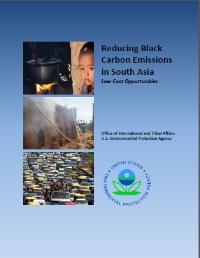Opportunities to Reduce Black Carbon Emissions in Asia
Certain pollutants known as "short lived climate forcers," such as black carbon, have a significant impact on the climate. Reducing black carbon can contribute to numerous sustainable development goals, such as cleaner and healthier air, food and water security, reduced mortality and the mitigation of climate change and its impacts.
South Asia has one of the highest concentrations of black carbon emissions globally. These emissions threaten the health of those living in the region. In addition, because of the possible impact on the Himalayan glacier system, the climate warming brought about by these emissions also threatens the available fresh water resources in this region.
Study: Reducing Black Carbon Emissions in South Asia
To assist interested parties in early actions to reduce these black carbon emissions, EPA conducted a study to identify and evaluate low cost and high-impact opportunities to reduce black carbon emissions in South Asia. These findings are covered in the report Reducing Black Carbon Emissions in South Asia: Low Cost Opportunities.
With a goal of informing those interested in immediate and effective actions, the report provides:
- examples of low-cost, high impact opportunities to reduce black carbon emissions in South Asia,
- a wealth of information and resources on reducing black carbon emissions in South Asia in the industrial, transportation and residential sectors, and
- a literature review synthesizing available literature on black carbon emissions and low cost mitigation options in South Asia.
Stakeholder Consultation
As part of the study, the United Nations Environment Programme (UNEP), EPA and the International Center for Integrated Mountain Development (ICIMOD) conducted a consultation with regional stakeholders Exit including government representatives, local and regional NGOs, black carbon researchers and practitioners in Kathmandu, Nepal, to identify current mitigation initiatives and new opportunities.
Learn more about this consultation in the April 2012 issue of UNEP's Black Carbon e-Bulletin (PDF) (see page 6). Exit
Early and sustained action on short-lived climate forcers, such as black carbon, is likely to slow the increase in near-term global warming.
What is Black Carbon?
Black carbon is made up of particles that enter the air as a by-product of the incomplete combustion of biomass, biofuels, and fossil fuels. Black carbon is emitted from many common sources such as cars and trucks, residential stoves, forest fires and some industrial facilities.
Black carbon particles darken snow and ice, influence cloud formation, and cause a strong warming affect in the atmosphere, by intercepting sunlight and absorbing it.
In addition to having an impact on climate, these particles are also known or are suspected to have a negative impact on human health, agriculture, precipitation patterns and the melting of snow and ice in the polar regions and on mountains.
Unlike greenhouse gases (such as carbon dioxide, which remain in the atmosphere for decades to millennia), black carbon remains in the atmosphere for only days or weeks.
Learn more:
- Reducing Black Carbon Emissions in South Asia Report
- EPA's Work on Black Carbon
- UNEP's Clean Air and Climate Coalition Exit
Contacts
For additional information on EPA's work on reducing black carbon emissions in South Asia, contact:
Yuolanda Tibbs
U.S. Environmental Protection Agency
Office of International and Tribal Affairs (2670R)
1200 Pennsylvania Ave., NW
Washington, DC 20460
E-mail: tibbs.yuolanda@epa.gov
(202) 564-6600

